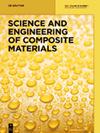船用水润滑轴承用智能橡胶壁板的设计与试验
IF 1.6
4区 材料科学
Q3 Materials Science
引用次数: 0
摘要
摘要水润滑轴承主要安装在船尾,用于支撑船舶主轴的旋转,主轴是船舶动力装置的重要组成部分。水润滑轴承的橡胶壁起到弹性体的作用,可以有效地抑制转轴的旋转振动,提高对轴效果。为了监测船尾水润滑轴承的运行状况,本文提出了一种智能型水润滑轴承橡胶壁的设计方法。根据橡胶壁的结构、光纤的封装和保护形式、橡胶壁的形成过程以及力学分析,确定了光纤布拉格光栅在橡胶壁中的分布设计原则。然后,FBG被包装、保护,并以不均匀的分布植入橡胶壁中,以实现轴承中的力传感。参考水润滑轴承在造船和船舶运行过程中的受力状态,利用弹性体试验机对智能橡胶冷却壁进行了各种状态监测试验,分析了载荷大小、频率和环境温度的影响。试验表明,在30°C以下的海水环境或内水环境下,橡胶冷却壁中的FBG可以监测轴承的静载荷和动载荷。该方法可用于水润滑轴承的智能设计和负荷状态在线监测。本文章由计算机程序翻译,如有差异,请以英文原文为准。
Design and testing of a smart rubber stave for marine water-lubricated bearings
Abstract The water-lubricated bearing is mainly installed at the stern of the ship to support the rotation of the main shaft of the ship, which is an important component of the ship’s power plant. The rubber stave of the water-lubricated bearing acts as an elastic body, which can effectively suppress the rotational vibration of the rotating shaft and improve the shaft alignment effect. To monitor the operational status of the water-lubricated bearing at the stern of a ship, a design method of smart rubber stave for water-lubricated bearings is proposed in this article. According to the structure of the rubber stave, the packaging and protection form of the optical fiber, the forming process of the rubber stave, and the mechanical analysis were carried out to determine the distribution design principle of the fiber Bragg grating (FBG) in the rubber stave. Then, FBGs were packaged, protected, and implanted with an uneven distribution into the rubber stave to achieve force sensing in the bearing. With reference to the force state of the water-lubricated bearing during shipbuilding and ship operation, various types of condition monitoring tests were conducted on the smart rubber stave using an elastomer testing machine, which were to analyze the effects of load sizes, frequencies, and ambient temperatures. The tests showed that the FBGs in the rubber stave could monitor the static and dynamic loads of the bearing under the seawater environment or inland water environment below 30°C. This method can be used for the smart designing and online load condition monitoring of water-lubricated bearings.
求助全文
通过发布文献求助,成功后即可免费获取论文全文。
去求助
来源期刊

Science and Engineering of Composite Materials
工程技术-材料科学:复合
CiteScore
3.10
自引率
5.30%
发文量
0
审稿时长
4 months
期刊介绍:
Science and Engineering of Composite Materials is a quarterly publication which provides a forum for discussion of all aspects related to the structure and performance under simulated and actual service conditions of composites. The publication covers a variety of subjects, such as macro and micro and nano structure of materials, their mechanics and nanomechanics, the interphase, physical and chemical aging, fatigue, environmental interactions, and process modeling. The interdisciplinary character of the subject as well as the possible development and use of composites for novel and specific applications receives special attention.
 求助内容:
求助内容: 应助结果提醒方式:
应助结果提醒方式:


